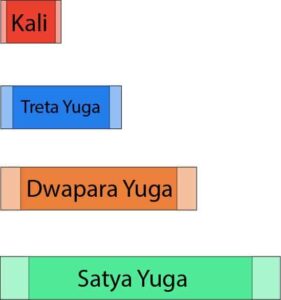
Treta Yuga is the silver age, the third of the four yugas. To understand what is Treta Yuga, we will discuss its duration, the various Vishnu avatars that appear in it, and other important symptoms. Treta Yuga marked the first time when social divisions arose and human society became hierarchical. A Yuga is a cosmic age according to the Vedic system of measuring universal time. The four yugas are Satya Yuga, Treta Yuga, Dvapara Yuga, and Kali Yuga. Together they comprise one full yuga cycle, and one thousand yuga cycles is equal to a day of Brahma, also known as a kalpa.
The Duration of Treta Yuga
In Vedic cosmology, various regions within the universe experience time differently due to the phenomenon of time dilation. For example, one year in the realm of Svarga is approximately equal to 720 solar years on our planet Earth.
For this reason, the Vedas give two different measurements for the duration of Treta Yuga. In years of the devas, Treta Yuga lasts 3,600 years, and on Earth, it lasts 3.456 million years. The duration of Treta Yuga is described in the Vayu Purana as follows:
tretādinī sahasrāṇi saṃkhyā munibhiḥ saha/
tasyāpi triśatī saṃdhyā saṃdhyāṃśastriśataḥ smṛtaḥ//
Three thousand years constitutes Tretā Yuga, with three hundred years of Saṃdhyā and three hundred years of Saṃdhyāṃśa (VP 1.32.57).
The most recent Treta Yuga ended approximately 1.738 million years ago.
| Time Unit | Solar Years |
|---|---|
| Kali Yuga | 0.864 million years |
| Treta Yuga | 1.728 million years |
| Dwapara Yuga | 2.592 million years |
| Satya Yuga | 3.456 million years |

General Overview
In Treta Yuga, the Silver Age, human beings engage in nonviolent religious sacrifice as a means of propitiating the gods and ultimately pleasing the Supreme Person, Vishnu. As Lord Krishna instructs Arjuna in Bhagavad-gita:
saha-yajñāḥ prajāḥ sṛṣṭvā purovāca prajāpatiḥ
anena prasaviṣyadhvam eṣa vo ’stv iṣṭa-kāma-dhuk
“In the beginning of creation, the Lord of all creatures sent forth generations of men and demigods, along with sacrifices for Viṣṇu, and blessed them by saying, ‘Be thou happy by this yajña [sacrifice] because its performance will bestow upon you everything desirable for living happily and achieving liberation.’”
devān bhāvayatānena te devā bhāvayantu vaḥ
parasparaṁ bhāvayantaḥ śreyaḥ param avāpsyatha
“The demigods, being pleased by sacrifices, will also please you, and thus, by cooperation between men and demigods, prosperity will reign for all.” (Bhagavad-gita, 3.10-11)
In order to facilitate collective sacrifice, human society was divided into four classes of men: brahmanas (intellectuals), kshatriyas (administrators), vaishyas (merchants), and sudras (workers). The brahmanas studied the Vedas and guided society with spiritual wisdom, the kshatriyas served as rulers, politicians, and army generals, the vaishyas worked in commerce and industry, and the sudras served the other three classes. However, there was not a spirit of envy or condescension among the four classes. Rather, each member of society sacrificed for the good of the whole and for the satisfaction of Sri Vishnu.
In Treta Yuga, human beings were extremely dutiful, moral, and compassionate toward their fellow living beings. They lived life spans up to 10,000 years. Although there was some division among society, it was nevertheless a time of overarching peace and prosperity.
Avatar for Treta Yuga
In each yuga, there is a specific avatara of Krishna who descends to guide humankind. As Krishna tells Arjuna in Bhagavad-gita 4.8:
To deliver the pious and to annihilate the miscreants, as well as to reestablish the principles of religion, I Myself appear, millennium after millennium.
In each yuga, there is a specific avatar who guides the humanity. For more information, read our article, Avatars of Treta Yuga.
LEARN MORE: The Puranas provide an advanced understanding of our universe, including descriptions of life on other planets. Check out our guide to Vedic Cosmology.
What Comes Next?
After Treta Yuga is Dvapara Yuga, the Bronze Age. Dvapara Yuga lasts 2,400 years of the devas, or 2.592 million human years. Check out our article to learn more about Dvapara Yuga.